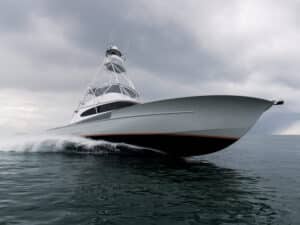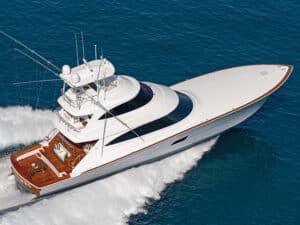
I can’t count how many boats Buddy Davis has made over his lifetime to date, but I sit up and take notice when he says that this 45 is the first one he has decided to keep for his personal use. And I can certainly see why. It addresses (and resolves) virtually every complaint anyone has ever had about express boats, and does it with grace and style.
Performance
Most boat tests last for a day. Certainly you can tell a great deal about a boat in a day; but living with a boat – that’s another story. I had the great fortune to spend a week in Marathon, Florida, with Davis, his crew and his boat. You get to know a boat much more intimately in that length of time. Every Davis boat design targets the same priorities: head-sea capabilities (which probably rightly tops the list), fishability, comfort and great looks. Throughout our week of fishing, ocean conditions remained static at about 4 feet and the wind southeast at about 10 knots. Admittedly, on some boats you don’t want to venture forth in anything bigger than steady 4-footers. The Davis 45 doesn’t recognize the existence of 4-foot seas.
Idling at 550 rpm with both engines, we made 6 knots; dropping one out of gear produced 4 knots. Of course, slow-idle and trolling gears allow you to almost stop dead in the water, so live-bait fishing poses no problems. I found a comfortable cruising speed at 1,950 rpm, running 28 knots using 56 gph. Detroit’s 60 Series engines tip the horsepower scale lower than the 2000 Series – 700 hp each to be exact. They push the 45 up onto plane in 17 seconds, which is neither the fastest nor the slowest time in the marketplace. You can order the 45 with twin 825-hp diesels, too. Davis estimates they’ll add 4 to 5 knots at the top end while offering approximately the same fuel consumption at speed. You must wait a bit after touching the tab buttons, as the boat responds slowly. I quickly learned that though there might be a slight delay in tab response, it’s nonetheless dramatic. You can move the bow through quite a range of adjustment.
As you’d expect from a Carolina boat, down-sea handling proved excellent on the Davis. The bow rises and settles gently, holding its course with impeccable accuracy. In fact, coming back from offshore and running without an autopilot, I timed 14 minutes before I needed to make a wheel adjustment.
Steering response represents the single most impressive aspect of performance on this 45. Once I saw how quickly it turned, I looked for opportunities to yank the wheel hard over. In the month since I ran the boat, I hear that everyone else who has driven it has enjoyed the same reaction. With only 2 1/2 turns lock-to-lock, turning hard over with throttle wide open results in a 180-degree turn in just about two boat lengths, with hardly any speed bleed-off. One final design aspect to consider is that you can also choose your new 45 with tunnels or a standard running surface. Tunnels reduce the draft from 4 feet 4 inches to 2 feet 11 inches.
Fishability
Thankfully, unlike many Carolina builders, Buddy Davis puts nonskid over the entire foredeck, bridge deck and everywhere else anyone might step. Those who fish from the bow or deploy the anchor offshore will especially appreciate the 45’s side decks – they are 4 inches wider than those on the Davis 47, making for a very comfortable and secure walk to the foredeck.
During the week, we tried all kinds of fishing. One day we drifted live baits about 24 miles south of Marathon in the Florida Keys. The slightly wider chines helped the 45 remain stable in a beam sea. Then we tried trolling the area and found the boat leaves a superb wake at all trolling speeds between 7 and 14 knots. Throughout that range, subsurface turbulence ends between the second and third wave back. The rest of the wake is all clear water
Bridge Deck
The most common complaint I hear from people who run express boats is, I hate the lack of visibility! Davis has solved that problem completely with a higher bridge deck that provides unobstructed visibility from the wheel. You can see the entire foredeck back to the spring cleats and all of the cockpit, of course.
You’ve also never seen better Davis styling, with a fixed windshield that rakes dramatically aft. You won’t see it in these photos, however, as our test boat – hull number one – had a roll-up enclosure that traveled just about straight up and down between the bridge deck coaming and the hardtop. Either way, seating, visibility and the standard air conditioning on the bridge deck provide a comfortable area that attracts a crowd – which, I noticed, helped keep the cockpit clear. Large L-shaped settees seat five on each side easily and contain copious storage space inside. For that matter, you’ll find just about every area of dead space aboard has been converted to storage space. A hidden overhead box hides electric teaser reels. I think about the only thing lacking on the bridge deck is an adequate number of drink holders. In his quest for perfection, I have no doubt that Davis will address that minor detail.
Interior
A steep stairway below decks empties into the portside galley. Forward of that resides a sofa and pullman berth, though future models may well have a showcase for all that expensive (and beautiful) tackle. The starboard side has a dinette/salon, then a full standing head with separate shower. Finally, the forepeak presents a large island berth in a private cabin. Davis’ plan B interior offers a second stateroom with over/under berths to starboard. As on deck, you’ll find storage under every settee, berth and box. Owners can choose among cherry, light maple or teak as interior joinery, as well as an infinite variety of fabrics and leathers. And strategically placed lighting, both direct and indirect, enhance the rich, luxurious ambience belowdecks.
Cockpit
Buddy Davis grew up fishing. He was a professional charter mate and captain long before he began building boats. That kind of experience leads to efficient cockpits. The 45 provides a large cockpit with coaming padding all around. Though future models will have an optional kill box in the transom, the current configuration without one makes for a smooth, clutter-free cockpit that four large anglers and a mate worked for several days without a problem.
The only scenario that might clutter the pit would be to combine a fighting chair with the transom box. I personally would stick with a sailfish rocket launcher and fish standing up to preserve the spaciousness. From the covering board that meets the top of my knee to the huge fish box in the cockpit sole, everything you need to fish comes as standard equipment. A starboard cockpit module at forward end contains a large baitwell; the port module houses a deep freezer, along with tackle storage drawers.
Engine Room
Here’s what I like best about the Davis 45’s engine compartment: I can stand upright with room to spare. The engine access proved slightly tight to someone of my bulk, necessitating a back-down entry. Once there, however, I found loads of space outboard of both engines, fuel separators and filters on the aft bulkhead (closer to the hatch) and emergency Y-valves for engine-assisted bilge pumps aft for quick and easy access from the entryway. I can’t imagine an engine room on a boat this size being any easier to work.
After spending a week with Davis on his newest model, I left agreeing with him wholeheartedly. I’d pick this 45-footer for my personal boat in a heartbeat, too.







